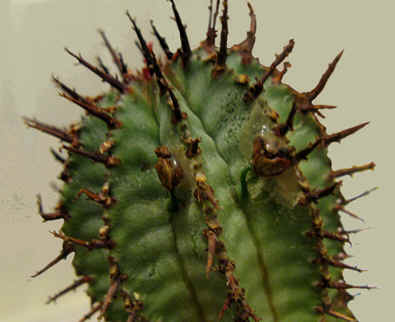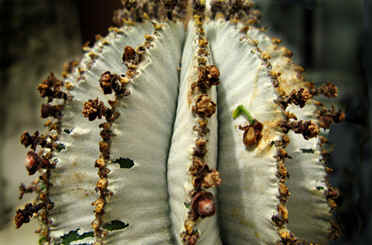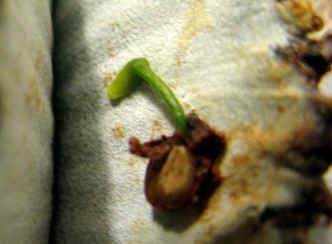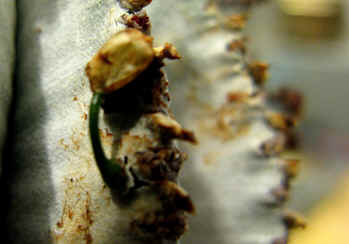Contents
of the Summer 2015 Northants News
|
Viscum
minimum Again
LLoyd
Gordon
|
Ed:
In
the last issue I wrote; “There
are bright green, fat fruits on my Viscum. Maybe they will turn red. (They
did!) Maybe
they will have viable seed. (They
are!) Maybe
I can rush round and infect all my Euphorbia obesa. Maybe not, but it would be
nice to see a project through.”
I
remembered I had been asked for seed many years ago and now happily posted some
off to Canada, (in bubble-wrap in a CD case to reduce squashing the berries).
The
recipient was Lloyd Gordon and here is Lloyd’s report...
|

|
First
of all, I’d like to thank Trevor for his very generous gift of the Viscum
minimum
seeds.
I’ve
been interested in parasitic plants for a number of years. I’ve been
trying to grow various (safe species) with a small degree of success.
Another generous grower sent me 2 cuttings of Euphorbia
horrida (one
of which died of cold damage in the mail). The cutting rooted and the Viscum
minimum grew
and flowered. I didn’t know which flowers were male or female and
fertilization was unsuccessful. Later the Viscum started growing again but
was attacked by mealy bugs and since then the inner parasite has been
almost invisible.
So
I was very happy to get a good number of Viscum
minimum seeds
from Trevor. These came at just the right time when the temperatures were
slightly above zero Celsius. Since then we’ve been in a deep freeze
(often -20C) and the seeds would have frozen in the mail. Anyway the seeds
were plump and green and mostly still inside the plumpish berries. One
even had a little radicl, (seed root), just sticking out.
Left:
Two
seeds of Viscum
minimum germinating
on Euphorbia
horrida
|
I
knew that Viscum seeds need a stable purchase on the host in order that the
haustorium has the mechanical leverage to penetrate the host epidermis. So using
delicate forceps, I carefully teased the seeds out of the berry along with the
sticky strands of viscum. I used the viscum strands to stick the seeds to the
host. I took as much of the sticky insides of the berry and used it to further
secure the seeds to the host. I then discarded the skin of the berries.
|

|
The
two host plants were under T5HO lights, 12 hours on/off, humidity at 25%
(that’s normal for centrally heated houses in Toronto, Ontario),
temperatures at 17°C lights off to 25°C lights on. I have no idea if
it’s necessary but I misted the seeds with distilled water daily.
The
majority of the seeds quickly produced radicles over the first 3-5 days.
These over a day or 2 more made contact with the host and then formed a
haustorial disc in order to penetrate the host. |

|
|
A seed of Viscum germinating
on Euphorbia ’Snowflake’
|
Detail of above showing the radicle
forming the primary haustorium on the host cuticle.
|
|
2-3 of the seeds didn’t have enough viscum and were too loose to allow
for firm haustorial contact. Using ‘5 minute’ epoxy (the kind you mix
two tubes), I carefully fixed them to the host with the haustoria in close
contact. I avoided getting any glue between the haustoria and the host as
this would have inhibited penetration.
It’s
been a few months and the seeds and haustoria seem to be doing what they
are supposed to be doing. The ones on the Euphorbia
polygona “Snowflake”
seem very closely adherent. The two haustoria on the E.
horrida are somewhat less closely adherent. Have they
failed to infect the host? Or have they already done their job and the
seed is ready to separate? Time will tell.
Right:
Another Viscum berry germinates |

|
It’s
been very interesting watching the seeds develop and I hope I will get some
Viscum growing outside the host and flowering - maybe I’ll even get some
berries to share with others.
Once
again, thanks to Trevor for the opportunity to grow these fascinating plants!
Lloyd
Ed:
Thanks
Lloyd for the article - a good swap for the seeds.
Having
plenty of seeds left over I decided to sow some myself. Life is a degree more
Spartan in Northants, England. In fact about 15 degrees Centigrade. The only
spare Euphorbia I had here were
rooted cuts of E.
mammillarias ‘Variegata’.
(No, I didn’t risk the E.
obesa.) I
thought that should things work out the red berries of the Viscum
would
contrast nicely with the sickly yellow of the Euphorbia.
They
germinated in summer in a cold greenhouse, dipping gently in and out of frost
near Christmas. When I read of Lloyd’s generous conditions I had an attack of
conscience and moved them to a plus 2°C
greenhouse. Whether the Viscum
has
actually taken up residence we will find out in due course.
Lloyd
wrote recently that there is no sign of Viscum
life
on his hosts but the
the
first signs will be short
stems bearing 3-part male or 4-part female flowers. Fingers crossed for both of us
this autumn.
Trev




